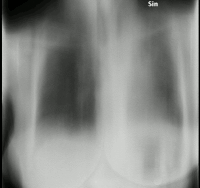
Photo from wikipedia
Tomosynthesis images are reconstructed from several projections. However, the number of projections is proportional to the exposure dose, and a reduction in the number of projections would result in a… Click to show full abstract
Tomosynthesis images are reconstructed from several projections. However, the number of projections is proportional to the exposure dose, and a reduction in the number of projections would result in a reduction of radiation dose to the patient but also degradation of image quality. The purpose of this study was to propose a new computerized method to supply interpolation images instead of real projection images for maintaining the number of projection images and image quality of reconstructed tomosynthesis images. A set of images comprising one-half the number of projection images [37 projections (Half set)], selected from the original full set of projection images [73 projections (Full set)], was used at an interval of one by one. In this study, the authors used a new linear interpolation technique (Shift-Linear method), which takes into account shifted distances between two corresponding pixels on two projection images. The image quality of tomosynthesis images reconstructed from the full set and the quasi-full projection images, which were produced from the Half set using the Shift-Linear method, was compared. Image quality was assessed in terms of modulation transfer function, noise power spectrum, contrast-to-noise ratio, and the detective quantum efficiency. Using this proposed method, the image quality of reconstructed tomosynthesis images could be maintained with the reduction of approximately 50% exposure dose.
Journal Title: Radiological Physics and Technology
Year Published: 2018
Link to full text (if available)
Share on Social Media: Sign Up to like & get
recommendations!